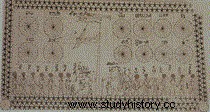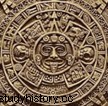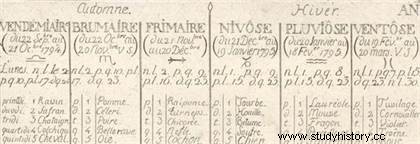 The calendar , as a system for measuring time, is a very old invention. The Sumerian scribes were the first to invent a lunar-type calendar comprising 12 months of 29 or 30 days, each of these months beginning on the evening of the appearance in the sky of the new lunar crescent. For a people on the way to civilization, it was essential to divide time in order to fix the major events of the community or the needs of daily life. Time is then divided into days, weeks, months and years. These divisions are based everywhere on the movements of the Earth around the Sun or the Moon around the Earth.
The calendar , as a system for measuring time, is a very old invention. The Sumerian scribes were the first to invent a lunar-type calendar comprising 12 months of 29 or 30 days, each of these months beginning on the evening of the appearance in the sky of the new lunar crescent. For a people on the way to civilization, it was essential to divide time in order to fix the major events of the community or the needs of daily life. Time is then divided into days, weeks, months and years. These divisions are based everywhere on the movements of the Earth around the Sun or the Moon around the Earth.
A calendar to divide time
In the 3rd millennium BC, the cities of Babylon were the first to use a calendar , corresponding to the movements of the Moon, to which they added if necessary additional months to maintain a correspondence with the seasons of the year. They also use a simplified calendar of twelve months and thirty days each. At the same time, under the reign of Djoser, the Egyptians instituted a calendar based on the three periods of agricultural activity in the country and which was also subject to repeated modifications.
The Egyptians replaced the lunar calendar with a calendar based on the solar year. It lasted 365 days and was divided into twelve months of thirty days each, at the end of which five days were added. A 354-day lunisolar calendar was used in ancient Greece; the Greeks were the first to insert the additional months according to scientific principles, at the end of a particular cycle. These first calendars carry with them the same objective as their successors, whether Julian, Gregorian, Jewish or Muslim:to enclose time in a regular and official cycle.
The Roman calendar
 The first Roman calendar, introduced around the 7th century BC, separated into ten months a 304-day year beginning with March. The months of January and February were added later, but another month had to be intercalated about every other year, because the months were only 29 or 30 days long. The days were designated by a method that involved counting backwards from three pivotal dates:calends at the beginning of the month, ides in the middle, and nuns, which fell on the ninth day before the ides. This calendar became hopelessly confused when the Roman rulers who were responsible for setting the days and months to be added abused their authority to extend their terms or change the date of elections.
The first Roman calendar, introduced around the 7th century BC, separated into ten months a 304-day year beginning with March. The months of January and February were added later, but another month had to be intercalated about every other year, because the months were only 29 or 30 days long. The days were designated by a method that involved counting backwards from three pivotal dates:calends at the beginning of the month, ides in the middle, and nuns, which fell on the ninth day before the ides. This calendar became hopelessly confused when the Roman rulers who were responsible for setting the days and months to be added abused their authority to extend their terms or change the date of elections.
In 46 BC, Julius Caesar decided, on the advice of the Greek astronomer Sosigenes, to establish a new calendar. This calendar, known as the Julian calendar, fixed the length of a normal year at 365 days and that of a leap year, every 4 years, at 366 days - the doubled day being that of February 24. Caesar also changed the start of the year to January 1 (instead of March 1).
Other examples
The Jewish calendar, derived from the ancient Hebrew calendar, has remained unchanged since 900 AD. This is the official calendar of the State of Israel and it remains the religious calendar of Jews around the world. The Jewish calendar is luni-solar and its months last alternately 29 and 30 days. An additional month is intercalated every 3 years based on a 19-year cycle called the Metonic cycle.
The Muslim calendar is calculated from the year 622, the day after the Hegira, when Muhammad fled from Mecca to Medina. The Islamic year has 12 lunar months and belongs to a 30-year cycle in which the 2nd, 5th, 7th, 10th, 13th, 16th, 18th, 21st, 24th, 26th and 29th years are leap years and have 355 days, the others being years to 354 days. The Gregorian date can be calculated to within one day from the Muslim date using the following rule:multiply the year of the Muslim year by 0.970224 and add 621.5774. The number obtained to the left of the decimal gives the year and the decimal part multiplied by 365 is the day of the year.
Native American calendars
 The Maya have two highly sophisticated calendars:a solar calendar and a ritual calendar. The first begins on the day of the zenith position of the sun (July 16) and has 365 days, divided into 18 months of 20 days plus 5 days. The ritual calendar has 260 days, divided into 13 periods of 20 days. The Maya express dates in both calendars.
The Maya have two highly sophisticated calendars:a solar calendar and a ritual calendar. The first begins on the day of the zenith position of the sun (July 16) and has 365 days, divided into 18 months of 20 days plus 5 days. The ritual calendar has 260 days, divided into 13 periods of 20 days. The Maya express dates in both calendars.
Very complex although obtained by simple means (such as the measurement of cast shadows and triangulation), the Mayan calendar remained the most reliable until the invention of the Gregorian calendar in the sixteenth century. It was developed through repeated daytime and nighttime observations of the Sun, Moon, Venus and other stars, which made it possible to identify positions and establish averages. Mayan astronomical sightings and calculations are nearly as accurate as ours.
The Aztecs also have a calendar system, developed before them by the Mayas. This system is made up of 365 days, divided into 18 months of 20 days, to which are added 5 “hollow” days considered to be very harmful. Another calendar, consisting of 260 days (20 months of 13 days), is exclusively reserved for divination.
The Gregorian Reform
The Julian calendar made the year 11 minutes and 14 seconds longer than the solar year. This difference accumulated so much that in 1582 the vernal equinox (see Ecliptic) fell 10 days before the calendar date. To make the equinox fall around March 21, as in 325 AD. J.-C. (year of the first Council of Nicaea, which had established the main rules of ecclesiastical computing), Pope Gregory XIII decreed that 10 days, that year, should be deleted from the calendar. He instituted a new calendar, since called the Gregorian calendar, by removing all secular leap years, except those whose vintage was divisible by 400. Thus, 1600 was a leap year, but 1700 and 1800 were normal years.
The Gregorian calendar was slowly extended to all of Europe. Nowadays, it is used in most of the Western world, as well as in some Asian countries.
Originality of the Republican calendar
 This calendar was instituted by the National Convention on October 24, 1793, during the French Revolution, to replace the Gregorian calendar . The republican calendar was created by Fabre d'Églantine and used in France from 1793 to 1806. Beginning at the autumnal equinox (22 or 23 September), the year was divided into twelve months of thirty days, themselves subdivided in three periods of ten days, the decades.
This calendar was instituted by the National Convention on October 24, 1793, during the French Revolution, to replace the Gregorian calendar . The republican calendar was created by Fabre d'Églantine and used in France from 1793 to 1806. Beginning at the autumnal equinox (22 or 23 September), the year was divided into twelve months of thirty days, themselves subdivided in three periods of ten days, the decades.
The name of the days corresponded to their number in the order of numbering:primidi, duodi, tridi, quartidi, quintidi, sextidi, septidi, octidi, nonidi, decadi. The last day of each decade was a rest day. The five or six “complementary” days that remained at the end of the year (from around September 17 to 21) were devoted to the celebration of the Republican holidays. The first year of the new system was called year I, the second year II, etc.
Three months were assigned to each season; the autumn months were called vendémiaire (“month of the grape harvest”), brumaire (“month of the mist”) and frimaire (“month of the Frost”); the winter months, nivôse (“month of the snows”), pluviôse (“month of the rains”) and ventôse (“month of the winds”); the spring months, germinal (“month of Germination”), floréal (“month of Flowers”) and prairial (“month of the Meadows”); and the summer months, Messidor (“Month of Harvest”), Thermidor (“Month of Heat and Baths”) and Fructidor (“Month of Fruit”). The republican calendar was abolished by Napoleon on January 1, 1806.
To go further
- History of the calendar:From the liturgy to the diary, by Francesco Maiello. Threshold, 1996.
- History of the calendar and the division of time. Mono, 2017.
